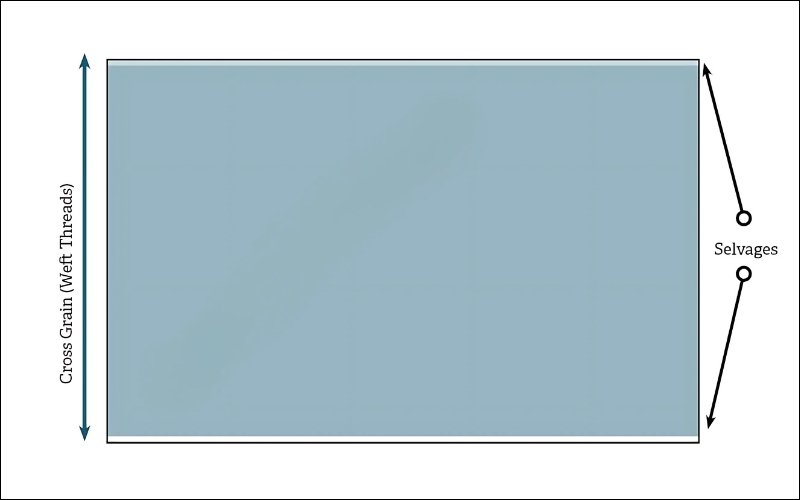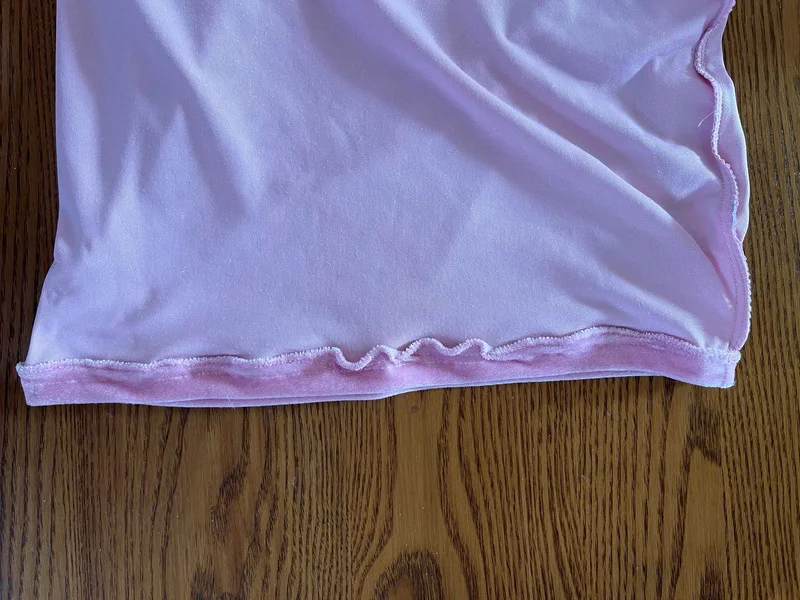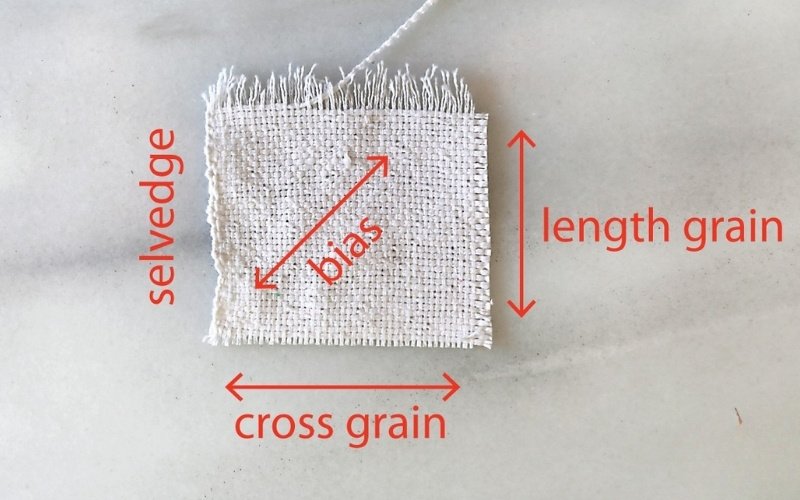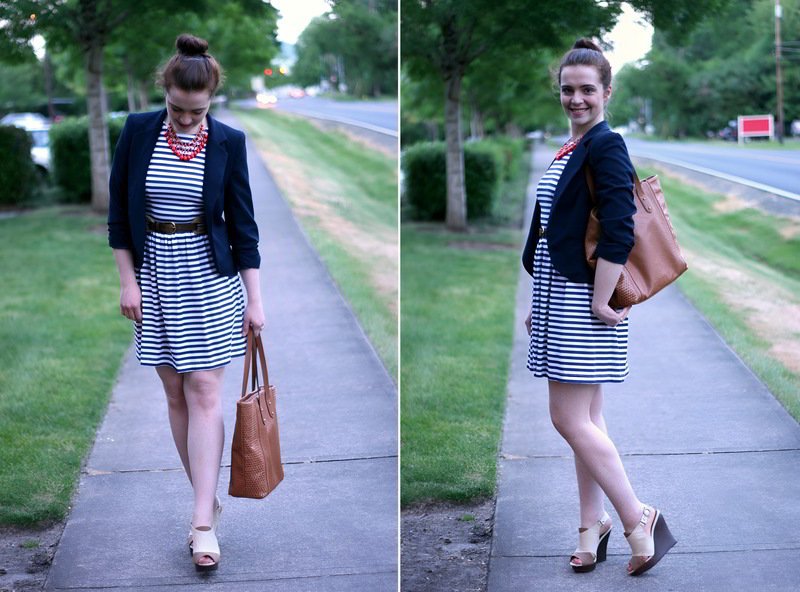What is Cross-Grain? Simple Fabric Guide: Why it Matters
Ever wondered what cross-grain is and why some garments hang beautifully while others twist? The secret often lies in understanding fabric’s inherent direction. This article demystifies the concept of cross-grain – the threads running across the fabric’s width – and explains its crucial role in achieving professional-looking results. Whether you’re a sewing beginner, a DIY crafter, or simply curious about textiles, you’ll discover why identifying and utilizing the cross-grain correctly is vital for garment drape, fit, and overall quality, helping you avoid common sewing frustrations.
1. Fabric basics: The building blocks of grain
1.1 What is fabric grain?
Fabric grain simply refers to the direction of the threads in a piece of woven fabric. It’s created when threads are interlaced during the weaving process (the creation of fabric by interlacing two sets of threads at right angles). Think of it like the lines or grid formed by these threads.
1.2 Understanding selvage
- What it looks like (finished edge): The selvage (or selvedge) is the tightly woven edge on either side of a fabric’s width. It looks different from the main fabric – often denser – and doesn’t fray. Sometimes, you might see manufacturer names or tiny pinholes from the loom along the selvage.
- Its importance as a reference point: The selvage is your main guide for finding the fabric grain. It’s like the starting point on a map. Knowing where the selvage is helps you identify the lengthwise grain, and from there, the cross-grain.

1.3 Lengthwise grain
Runs parallel to the selvage: The lengthwise grain is made up of threads that run up and down the fabric, parallel to the selvage edges. These are called warp threads (the long, strong threads that are set up on the loom first).
Usually the strongest, least stretchy direction: The lengthwise grain is generally the strongest direction of the fabric. It usually has the least amount of stretch in woven fabrics. This is important for how garments hang and last.
1.4 Weft threads
Threads that run from selvage to selvage, across the fabric width: Weft threads are the threads that are woven back and forth across the warp threads. They run from one selvage edge to the other, filling in the fabric and creating its width.
These threads create the cross-grain: The direction of these weft threads is what forms the cross-grain of the fabric. This is key to understanding our main topic.
2. What exactly is cross-grain?
2.1 Defining cross-grain (or crosswise grain)
Cross-grain, also known as crosswise grain, is the fabric direction that runs perpendicular (at a 90-degree angle) to the selvage edge. It follows the path of the weft threads (those threads going side-to-side across the fabric). So, if the selvage is the fabric’s length, the cross-grain is its width.

2.2 Characteristics of cross-grain
In most woven fabrics, the cross-grain often has slightly more stretch or “give” than the lengthwise grain. This happens because the weft threads are woven over and under the warp threads, allowing for a little movement when pulled.
This subtle difference isn’t like the stretch in knit fabrics, but it’s important for garment fit. This slight give can also affect how the fabric drapes (how a fabric hangs or falls), sometimes making it appear softer or cling more when the cross-grain is oriented vertically.
2.3 Visualizing cross-grain
To easily picture the cross-grain, lay your fabric flat. If the selvages are on the left and right edges (this is usually how fabric comes off a bolt, representing its width), the cross-grain runs horizontally, from left to right across that width. It’s the direction that goes across your body in most clothes.
2.4 Understanding “bias” briefly
It’s also helpful to know about the bias. The true bias is the direction at a 45-degree angle to both the lengthwise and cross-grain. This diagonal direction has the most stretch in woven fabrics. While this article focuses on cross-grain, knowing bias exists helps understand fabric behavior better. We won’t go deep into bias here, but it’s good to know it’s different from cross-grain.
3. Why is understanding cross-grain so important for your projects?
3.1 Achieving proper garment fit and hang
The slight give on the cross-grain can help fabric mold and flow around curves better. This is why the cross-grain often goes around the body in garments like skirts or bodices, leading to better comfort and appearance.
Ignoring the cross-grain can lead to common sewing problems:
- Twisted pant legs or sleeves.
- Uneven or sagging hems.
- Side seams pulling or looking strange.
Understanding and using the cross-grain correctly helps prevent these issues and ensures your clothes fit and hang as intended.

3.2 Pattern alignment and cutting
Sewing patterns have a long arrow printed on each piece. This is the grainline arrow. Usually, it indicates the lengthwise grain, meaning you must align this arrow parallel to the fabric’s selvage. However, some patterns may specifically instruct you to cut a piece on the cross-grain. In this case, you would align the pattern’s grainline arrow perpendicular to the selvage.
Following these grainline markings is crucial. To do this accurately, measure from the selvage to both ends of the grainline arrow on your pattern piece, ensuring the distances are equal. This guarantees the piece is correctly aligned with the fabric’s grain.
3.3 Fabric stability and durability
Generally, the lengthwise grain (made of warp threads) is stronger and resists stretching more than the cross-grain. This is why it’s often used for parts of a garment that need stability, like the length of pant legs. The cross-grain, with its slight give, is good for comfort around the body. However, if misused in an area needing strength, it might distort more easily under stress.
Using the correct grain for each pattern piece contributes to the item’s longevity and structural integrity. Incorrect grain placement can lead to stretched-out areas, puckered seams, or the garment losing its shape over time.
3.4 Working with prints and stripes
If your fabric has a directional print (like flowers all pointing one way) or stripes, the grain direction is very important for the final look. Cutting on the lengthwise grain will mean the print or stripes run vertically down the length of your pattern piece, and subsequently, your finished garment section. Cutting on the cross-grain will orient them horizontally. Understanding this helps you achieve the desired visual effect and match patterns correctly.
4. How to find the cross-grain on your fabric: Easy methods
4.1 Method 1: Using the selvage as your guide
This is the most reliable way to find the cross-grain:
- Spread your fabric on a flat surface.
- Identify the selvage edge(s).
- The cross-grain runs at a perfect 90-degree angle (like the corner of a square) from the selvage, across the fabric’s width.
- You can use a quilting ruler or a T-square. Align one edge of the ruler with the selvage; the edge at 90 degrees to it will show you the true cross-grain.

4.2 Method 2: The stretch test
- Gently pull a small section of your fabric parallel to the selvage (this is the lengthwise grain). Note how much it stretches (usually very little for woven fabrics).
- Now, gently pull the fabric in the direction perpendicular to the selvage (this should be the cross-grain). You will often feel slightly more give or stretch in this direction for most woven materials.
Be cautious: This test is more noticeable in some fabrics than others. Very stable fabrics, like some tightly woven cottons or denims, might show very little difference in stretch. Also, don’t confuse this subtle give with the much greater stretch found in knit fabrics.
4.3 Method 3: Looking at the weave (for some fabrics)
For fabrics with a more open or distinct weave, such as some linens or coarser cottons, you might be able to visually identify the weft threads. These are the threads running across the fabric, perpendicular to the selvage. A magnifying glass can sometimes help. However, this method is often less reliable for beginners than using the selvage as a guide.
4.4 Tip: Straightening the fabric grain if it’s off
Sometimes fabric can be pulled crooked when it’s rolled onto the bolt at the store or during handling. If your cut edge isn’t straight with the grain, your project pieces can end up skewed.
Here are two common methods to straighten the grain:
- Tearing method: For suitable fabrics like many quilting cottons, you can snip into the selvage and then tear the fabric across its width. It will naturally tear along a weft thread (cross-grain). Always test this on a small scrap first, as not all fabrics tear cleanly.
- Pull-a-thread method: Snip near the cut edge of your fabric. Carefully pick out one weft thread and gently pull it. It will gather the fabric, creating a visible line or channel along the true cross-grain. You can then cut smoothly along this line.
5. Cross-grain vs. lengthwise grain: Key differences
Understanding the distinctions between cross-grain and lengthwise grain is fundamental for successful sewing.
5.1 Direction
- Cross-grain: Runs perpendicular (90-degree angle) to the selvage. It follows the direction of the weft threads.
- Lengthwise grain: Runs parallel to the selvage. It follows the direction of the warp threads (the long, strong threads set up on the loom first).
5.2 Stretch (in woven fabrics)
- Cross-grain: Usually has a little more give or stretch.
- Lengthwise grain: Typically has very little or no stretch.
5.3 Strength
- Cross-grain: Generally less strong than the lengthwise grain.
- Lengthwise grain: Typically the stronger, more stable grain direction.
5.4 Drape
- Cross-grain: Can offer a softer drape or conform more readily to curves, depending on how it’s used in a garment.
- Lengthwise grain: Often provides a crisper or more structured drape. Most garments are designed to hang with the lengthwise grain running vertically.
5.5 Common uses
- Cross-grain: Frequently used for garment width (e.g., around the body for skirts, shirts), cuffs, waistbands, yokes, or when horizontal pattern effects (like stripes) are desired.
- Lengthwise grain: Most commonly used for the length of garments (e.g., pant legs, skirt length, main bodice front and back pieces) due to its strength and stability. This is the default for most pattern grainline markings.
6. When might you intentionally use the cross-grain?
6.1 Specific design effects
Designers and sewists sometimes choose to use the cross-grain intentionally for visual impact:
- Stripes/border prints: To make stripes run horizontally around a garment (like a skirt) or to place a border print along a hemline, you would cut the pattern piece on the cross-grain.
- Garment parts: Specific garment components like yokes (the fitted part of a shirt across the shoulders), cuffs, or waistbands are often cut on the cross-grain. This can be for stability across their shorter dimension, for a slight give to improve fit, or to orient a fabric pattern (like plaid) in a contrasting direction. Always follow your pattern’s instructions. Fashion designers, for instance, might cut a collar on the cross-grain to make a plaid pattern run differently from the main shirt body, creating an interesting detail.

6.2 Utilizing fabric efficiently
Sometimes, especially with very wide fabrics or when cutting out oddly shaped pattern pieces, placing some smaller or less critical pieces on the cross-grain can help you save fabric. However, this should only be done if the change in grain direction won’t negatively affect the piece’s function, fit, or the overall structure of the garment. It’s usually best for pieces where the grain direction is less critical.
6.3 Matching patterns
For fabrics with plaids or other symmetrical patterns, designers sometimes intentionally cut adjacent pieces on different grains or use the cross-grain to achieve specific visual effects at seams. This can create effects like chevrons (V-shapes) with plaids or ensure continuous horizontal lines across seamlines. This is a more advanced technique that requires careful planning.
7. Frequently asked questions (FAQs) about cross-grain
7.1 Is cross-grain the same as weft?
Cross-grain follows the direction of the weft threads. The weft threads are the actual yarns woven across the fabric, and “cross-grain” is the term used to describe this direction or orientation in the fabric.
7.2 Can I always cut on the cross-grain if I want more stretch?
While the cross-grain in woven fabrics often offers some subtle give, it’s not the same as the stretch you’d find in knit fabrics or fabric cut on the bias (the diagonal direction of a woven fabric, which has the most stretch). The amount of give on the cross-grain varies significantly between different fabric types. For significant stretch, bias cutting or using knit fabric is usually a better choice.
7.3 What happens if I accidentally cut my pattern piece against the cross-grain when it should be on it?
Cutting against the intended grain (e.g., on lengthwise when cross-grain is specified, or vice-versa) can cause several problems. The garment piece might twist, pull awkwardly, drape poorly, or fit uncomfortably. If the fabric has a directional print, it will also end up facing the wrong way. The item likely won’t hang or wear as the pattern designer intended.
7.4 Do all fabrics have a clear cross-grain?
Most woven fabrics (like cotton, linen, wool, denim, silk) have a distinct cross-grain and lengthwise grain. Knit fabrics have a similar structure with “courses” (like cross-grain) and “wales” (like lengthwise grain), but their properties, especially stretch, are different. Non-woven materials, such as felt, interfacing, or vinyl, do not have a grain in the same way because they are not made by weaving or knitting threads.
7.5 Does cross-grain affect how a fabric shrinks?
Yes, potentially. Fabrics can sometimes shrink differently along the cross-grain compared to the lengthwise grain. This is one of the reasons why pre-washing your fabric before cutting is often recommended, as it allows any initial shrinkage to occur evenly.
Read more:
To sum up, cross-grain is simply the direction of threads running across the width of your fabric, from selvage to selvage, at a right angle to the lengthwise grain. Understanding and correctly using the cross-grain is key to achieving garments that fit well, drape beautifully, and have a polished, professional finish. It helps prevent many common sewing issues. Don’t worry if this seems like a lot to remember at first.
With a bit of practice looking at your fabrics and paying attention to pattern instructions, identifying and using the cross-grain will become an easy and natural part of your sewing process. Understanding fabric grain helps create quality products. Let Packlove enhance them further with our premium custom labels and packaging. Explore our solutions or contact us today for expert advice!






















